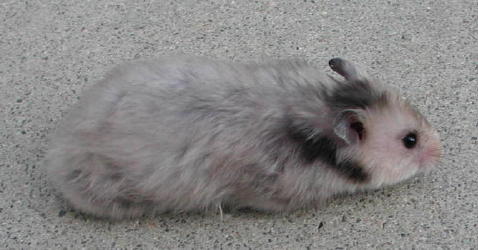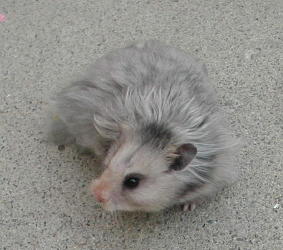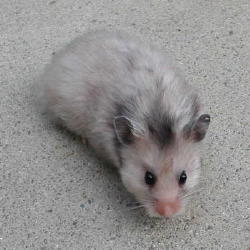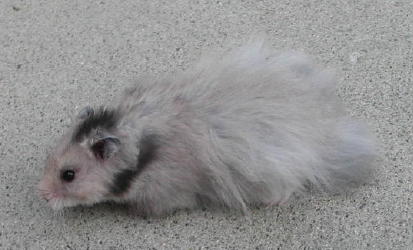

Dark Gray was first documented in 1964. The mutation was found in the United States, in a line of heavily inbred Rusts. It was described in an article titled Dark Grey and Lethal Grey Two New Coat Color Mutations in the Syrian Hamster which appeared in the Journal of Heredity Volume 58, pages 295-296, 1967 by Nixon and Connelly.
Dark Gray Syrian Hamsters were unconfirmed within the U.S. Hamster Fancy until two were imported from Sweden in the spring of 2003. Shortly thereafter an unrelated Dark Gray hamster was dumped on the doorstep of a rescuer. This finally proved that the gene was present in North America, and since that time there have been several confirmed sightings in pet stores. It is obvious the gene exists in the stock of at least one of the big commercial breeders although it is not seen with any frequency.
Description
Dark Gray hamsters are a beautiful deep blue gray with heavy black ticking. They should have crisp, dark markings and be very distinctive in appearance. They are an agouti variety and they should have no yellow color to them. Their undercolor is a deep gray, with a gray top color ticked in black. They have solid black cheekflashes and almost white crescents.
The BHA standard calls for:
Top Coat: Pearly Grey carried approximately one-quarter of the way down
Base Color: Dark Slate grey
Belly Fur: Ivory with grey undercolor
Crescent: Ivory
Ticking: Heavily and evenly ticked with black-face to be swarthy with black eye rings
Chest Band: Very Dark Slate Grey
Cheekflashes: Black
Eye Colour: Black
Ear Colour: Dark Grey almost Black
Dark Gray differs from Silver Gray and Light Gray in every way and is very distinct in its own right. Some people may look at it and label the color blue. This is very inaccurate as the gene is in no way similar to blue which at this time does not exist in the Syrian hamster fancy.
This color is attractive in all the coat varieties. As in most colors, Satin will darken Dark Gray and Rex will cause a lightening of the ticking in the coat.
Many sources note that from their initial discovery Dark Gray hamsters have been smaller than their counterparts. This is particularly noticeable when they are younger, and most do catch up as they mature.
Dark Gray is also notable because of the high incidence of spinal deformities within the color. They are prone to a defect which causes their tail to be short, curved, or kinked. While this defect does not appear to be seriously detrimental to the effected animal, it is hereditary and should be avoided at all costs when breeding.
Breeding
Dark Gray is a simple recessive gene (dg) expressed on an agouti animal. Breeding a Dark Gray to a hamster who does not carry Dark Gray will result in no Dark Gray offspring. All will be carriers however. If two offspring are paired together, about 25% of the resulting pups will be Dark Gray. If two Dark Grays are mated, the entire litter will be Dark Gray (or Dark Gray combination colors if the parents carry other genes).
Continually breeding Dark Gray to Dark Gray is reported to result in a
lightening of the color and in an increased incidence of spinal defects. The best outcross for Dark Gray is a Golden. Dark Gray is often muddied or lightened when the animal carries other genes, so this is a color where pure animals are preferred when it is possible to obtain them. Dark Gray plus Black (aadgdg) is unexceptional and looks much like a dingy black in appearance.


It is difficult to achieve the depth of color and the heavy ticking that is called for in the standard for the Dark Gray. Both are effected when other genes are carried, and the best show animals ideally are pure. Dark Gray tends to go brown early, with most showing some signs by one year of age. This is accentuated if they carry cream, so that combination is best avoided.
Many reports mention that Dark Grays are smaller than their non-Dark Gray counterparts and Chris Henwood notes that this should be taken into account when judging. Other authors suggest that most Dark Grays do catch up in size eventually, and of course the goal should always be an animal with nice size and type. It is something to keep in mind when dealing with young animals however.
Dark Gray is not a good color choice for the novice exhibitor, or the person looking for an easy variety. A truly good example is hard to come by and does not have a particularly long show life.
Dark Gray Combination Colors
While it is ideal for a Dark Gray to be pure and not carry other genes, this is in truth rarely the case in the U.S. The imported animals carried several other genes, and of course the animals now occasionally seen in pet stores are coming out of very unknown and probably mixed up breedings done by large commercial breeders. Fortunately, Dark Gray in combination with other genes does produce some truly beautiful other colors which we are finally seeing in the US now that the gene is available and being worked with. Any color produced by the Dark Gray
gene (dg) has an increased chance of spinal defects which cause bent or curled tails. This problem should be watched for and no effected animals should ever be bred.
Lilac dgdgpp (Dark Gray + Cinnamon)
The standard calls for a soft pastel gray with a pink tone. Their eyes are claret red and their ears a pinkish gray. They often brown with age and many lack depth of color.
Lilac Pearl dgdgppToTo (Dark Gray + Cinnamon + Yellow)
Their coat is a pale pinkish gray with light gray ticking. Eyes are red and the ears flesh colored. The first record of them being created was in 1988 and they are sometimes also called pink or pink pearl.
Beige dgdgbb (Dark Gray + Rust)
Dark Gray originated in a line of Rusts, so this color appeared in 1964 along with Dark Gray. The standard calls for a pale gray top coat lightly ticked with Dark Brown and with a mid gray base color. The undercolor should be similar to a good Lilac but with more ticking on the Beige. The eyes are black and the ears a very dark beige. A common fault is a lack of good ticking, in which case they resemble a poor Lilac.
Smoke Pearl dgdgToTo (Dark Gray + Yellow)
The standard calls for a pale pearl gray heavily and evenly ticked with black. The eyes are black and the ears a dark gray. This color is darker than Black Eyed Ivory, and of course is distinguishable by its dark ticking, which develops with age. A Smoke Pearl carrying Cream will brown badly and have brown ticking, so it is a combination best avoided.
Black Eyed Ivory eedgdg (Dark Gray + Black Eyed Cream) *
This color is an even pale grayish cream with no ticking or markings. The eyes are black and the ears dark gray. This color tends to yellow with age.
*note Black Eyed Ivory can also be produced using Light Gray or Silver Gray
Red Eyed Ivory eedgdgpp (Dark Gray + Black Eyed Cream + Cinnamon)**
The standard calls for a soft pale grayish cream with no ticking or markings. Eyes are Garnet and east a light pinkish gray. Like Black Eyed Ivory they tend to yellow with age.
**note Red Eyed Ivory can also be produced using Light Gray or Silver Gray
Dark Gray Tortoiseshell dgdgToto (Dark Gray + Yellow)
Dark Gray torts can be rather striking dark gray with clear Smoke Pearl patches if they have good markings. Like any Tort, they vary in the size and distinctiveness of their patches. If they carry cream the patches will lack ticking and be closer to Ivory in color. Dark Gray Black Tortoiseshell is also striking, producing a black hamster with off white patches. Dark Gray will reportedly muddy the Black however, and the color is unstandardized.